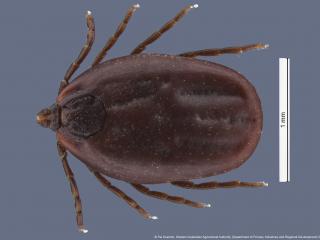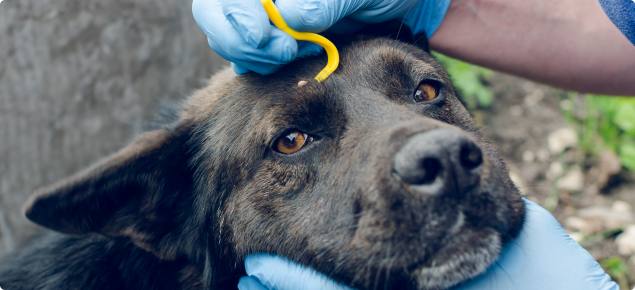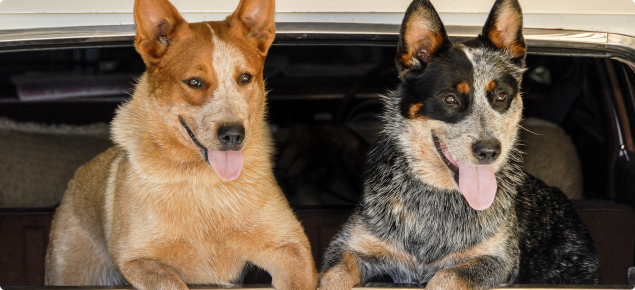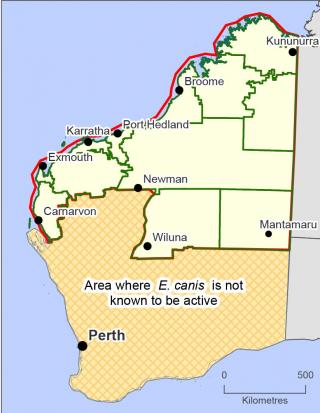Ehrlichiosis in dogs in Western Australia
E. canis occurs around the world, particularly in tropical and subtropical regions. Infection with E. canis (ehrlichiosis) was confirmed for the first time in Australian dogs in May 2020 in the Kimberley region of WA. The disease has also been confirmed in dogs in the Pilbara, Gascoyne and northern Goldfields of WA, northern South Australia and Queensland.
| Ehrlichiosis in dogs must be reported |
|---|
| Infection with E. canis (ehrlichiosis) is a notifiable disease in Australia. If you think a dog has ehrlichiosis, call your private veterinarian, Department of Primary Industries and Regional Development (DPIRD) veterinarian or the Emergency Animal Disease Watch hotline on 1800 675 888. |
How do dogs become infected?
Dogs develop ehrlichiosis after being bitten by a brown dog tick (Rhipicephalus sanguineus) infected with E. canis. The brown dog tick is widely distributed worldwide and is present across northern Australia.

Dogs do not directly transmit the disease to each other. The disease is maintained by a cycle of transmission between ticks and dogs.
Signs of ehrlichiosis
Ehrlichiosis has three possible phases of disease: an ‘acute’ phase or early signs of disease, a ‘subclinical phase’ where there are no obvious signs of disease, and a ‘chronic’ or long-term stage.
The severity of the disease varies considerably with the phase.
Acute phase
The acute phase of the disease develops about 1-3 weeks after the tick bite and typically lasts for 2-4 weeks. Initial signs of infection are non-specific and may last 2-4 weeks.
The dog may have:
- fever
- lethargy
- swollen lymph nodes
- be off their food
- weight loss
- unusual bleeding or bruising.
Subclinical phase
Some dogs appear to fully recover from the acute phase and no longer look sick but are actually in the subclinical phase of the disease, as the bacteria remains in the spleen or bone marrow for years. The dog may test negative to blood tests as E. canis is not in the bloodstream in this phase. Dogs may stay in this phase or progress to the chronic form of the disease.
Chronic phase
Only some infected dogs will go on to relapse and develop the chronic form of ehrlichiosis. Chronic disease signs are similar to those in the acute phase but are more severe. They can include:
- fever
- weakness
- weight loss
- unusual bleeding or bruising, including blood from nose
- pale gums
- runny eyes and nose.
Infected dogs may be more likely to develop other infections at the same time. The chronic form of the disease can be fatal.
Diagnosis and treatment
Infection with E. canis (ehrlichiosis) is a notifiable disease in Australia. This means if you think a dog has ehrlichiosis, you must call your private veterinarian, DPIRD veterinarian or the Emergency Animal Disease Watch hotline on 1800 675 888.
The veterinarian will collect samples from dogs with signs of ehrlichiosis and submit them to DPIRD's Diagnostics and Laboratory Services (DDLS) for diagnostic testing.
Ehrlichiosis is treated with antibiotics, supportive care and may require hospitalisation depending on the severity of the infection. Early treatment by your veterinarian provides the best chance of recovery.
Diagnostic testing for dogs without signs of E. canis will no longer qualify as being charge-exempt. Diagnostic testing will be available in these circumstances on a fee-for-service basis, either via DDLS or Vetpath. Please contact animalbiosecurity@dpird.wa.gov.au for a guide on fees and charges.
Laboratory submission information for veterinarians
Private veterinarians are requested to use two submission forms when submitting samples for E. canis testing:
- DDLS Ehrlichia canis laboratory submission form (form will download when link is clicked) and the
- DDLS animal disease investigation submission form (right click to open in new tab)
Please ensure you follow the shipping instructions included in the E. canis laboratory submission form.
Preventing ehrlichiosis
To help prevent ehrlichiosis occurring:
- Where possible, avoid taking your dogs into brown dog tick-infested areas.
- If living in or travelling to areas where the brown dog tick is present, such as northern WA (see map), ensure your dog is on an effective tick preventative. Veterinarians can provide advice on the most suitable tick prevention and control products for your situation.
- Tick collars and spot-ons that repel and kill brown dog ticks are the best primary protection, as they can help prevent the tick attaching to the dog. This is important as once the tick has attached, it may only take three hours to infect the dog.
- Tablets and chews registered for brown dog tick control provide an additional layer of protection but are not sufficient to prevent infection without an effective repellent.
- Inspect your dog daily for ticks, especially if they have been in a tick-infested area. Run your fingers through your dog’s coat over their skin and feel for abnormal bumps. Pay particular attention to the head and neck, inside their ears, on their chest, between their toes and around their mouths and gums.
- If you find ticks on your dog, ask your veterinarian for advice on the best way to remove them. Also treat the places where the dogs sleep in your house and yard for ticks to prevent the dogs being reinfested.
- If you are travelling with your dogs to northern WA, try to prevent them entering tick-infested environments and having contact with other dogs which may be carrying ticks. This includes places where you may stop, like fuel stations and caravan parks.
Moving dogs into or within WA
DPIRD continues to support surveillance and management of E. canis, however regulated interstate and intrastate movement conditions of dogs no longer apply.
Recommendations when moving dogs
It is recommended that all dogs being moved into, out of, or within northern WA, or areas where E. canis may be active:
- are not showing any signs of E. canis
- are treated with a registered tick product effective in the prevention of the brown dog tick (Rhipicephalus sanguineus), even if ticks are not seen
- are checked regularly for attached ticks and coats kept short to make it easier to see ticks
- have their bedding and yards regularly treated for ticks
- are taken to a veterinarian if after movement they show signs of fever, lethargy or weakness, bleeding or bruising, not eating or weight loss.
Dog adoption and rehoming
When adopting a dog from an area where E. canis is or may be active, ensure you are aware of:
- the dog’s health history including illnesses, treatments and tick preventatives
- the signs of ehrlichiosis
- dog movement conditions for movement into or within WA
- diagnosis, treatment and prevention of ehrlichiosis.
Human health and ehrlichiosis
While infected dogs do not directly transmit ehrlichiosis to people, in rare cases, infected ticks may transmit E. canis to people. See the WA Department of Health website for information on human health implications associated with ticks, as well as prevention, removal and first aid advice.
More information
If you think your dog may have E. canis, contact:
- your private veterinarian or
- local DPIRD veterinarian or
- the Emergency Animal Disease Watch hotline on 1800 675 888.




